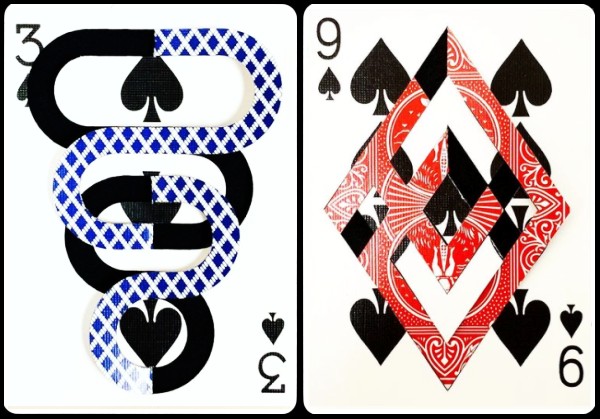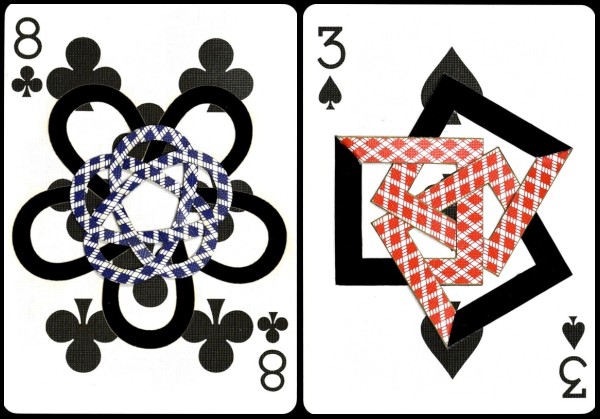
Kirigami
Undoubtedly you’ve heard of origami, which is the art of folding paper into various shapes. It is typically associated with Japan, and the word literally means folding (“ori”) paper (“kami”). The Japanese term for cutting paper on the other hand is kirigami, and is derived from the word to cut (“kiru”). A simple example of kirigami that most people will have tried in their childhood is the creation of a paper snowflake, where you fold a paper in half and then thirds before cutting it, to create a symmetrical pattern. Symmetry is a common feature of kirigami, and most kids will have experimented with making a paper chain of dolls or a Chinese paper lantern.

Scott Dyer
If you want to get some sense of the amazing possibilities of kirigami with playing cards, you simply must check the stunning gallery of creations by American creator Scott Dyer. Scott is somewhat of a jack-of-all-trades when it comes to playing cards, because he also does a number of other things like card stacking. His current best is a tower of playing cards that was 6.25m high, which is really not that far from Bryan Berg’s current world record of 7.87m. The sky is the limit, as they say, but on that occasion the limit was the length of Scott’s ladder. He does have his heart set on breaking the world record someday, but this would require a considerable amount of time, and equally the right building and space.

True topological cards
It is not my intention to give an authoritative categorization of different types of kirigami cards. Like Scott, I’m not so much interested in making strict scientific distinctions, as I am in enjoying the visual artwork of these delightful creations. So bear in mind that some practitioners of kirigami may interpret the suggested categories below differently. But these are some categories that Scott suggests, and who am I to argue with him – I just want to enjoy the beautiful art that results!Trapdoor fold
This is the first of several categories that can be considered “true topological” cards, because they uphold the strict criteria of being continuous pieces, with no detachments or glue or trickery, and they are fully examinable. The trapdoor fold is the bread-and-butter fold for kirigami cards, and is the key element of the cards pictured here.
Cat’s grin fold
A hinge point in the middle of the card is key to many of these, while more complex designs increase the number of crossing points to produce very impressive visual aesthetics.
Folded/woven stems
These typically have long steps of shapes that are folded and interlocked or woven into themselves, often producing an apparently impossible look.Rotationally symmetric/geometric knots
The way these work produces a very visually pleasing effect, but in most instances they look more complicated than what they actually are, and don’t require the same “impossible” folding techniques used in some of the previous examples.
Braided cards
Now let’s ramp up the difficulty somewhat, at least in terms of how the result looks. These build on earlier techniques, but look more complex and really maximize the number of crossing points for a stunning effect.
Other cards
One-way topological
Unlike the “true topological” cards of all the preceding categories, there is somewhat of an illusion at work here. Even so, these designs still use continuous pieces that rely exclusively on twisting and folding, with no detaching or glue involved.
Topologically impossible
Finally there is some genuine trickery involved – although when you’re examining them you may still find it impossible to figure out how these have been accomplished.
Mystery box cards
Scott also has tried his hand at creating 3D pop-up cards, which he refers to as a “mystery box”. Those who have the Bad Robot deck might recognize what inspired this name. It originates with the Mystery Box decks from Theory11, where a Bad Robot deck was wrapped in plain brown packaging, and advertised by the creator J.J. Abrams as a “mystery box”. But Scott has put his own spin on the name, and in his case it refers to a 3D design created out of a single playing card. For a while he even challenged himself to create a new mystery box every single week, and over time he has produced over 125 different designs.

Give it a try!
Now it is your turn! The basic tools for kirigami are easily obtained. Ideally you want to use some kind of cutting mat, and you will find self-healing mats that work particularly well. In a pinch, there’s always good old cardboard. You’ll also need a sharp hobby or craft knife, such as the popular X-Acto brand. Finally, to help you ensure that your cuts are straight – and also for your own self-protection – a steel ruler will be of great benefit. As for what designs to use, there’s no real secrets here. Just check out some photos of designs created by others, and it is clear where the cuts need to happen. The tricky part tends to be figuring out how to do the folding. But that’s effectively a puzzle you’ll have to solve on your own, and that’s all part of the fun! Scott’s technique is to create the design digitally on his computer first. He then re-sizes it to match a playing card, and tapes the printed template to a playing card for accurate cutting. He recommends printing an oversized design on a full sheet of paper first to help with figuring out how the folds work. A good place to start might be by tackling some of the mystery boxes that Scott has made. To help you out, he’s provided templates in PDF form that you can freely download and use.
Other sources
I appreciate how Scott Dyer makes it very clear that he is standing on the shoulders of those who have gone before him, and he also tries to credit and attribute his work carefully where possible. For his mystery boxes he’s done a lot of research on kirigami pop-up designs, many of which he’s reverse engineered and found ways to apply to a single playing card. For the other kirigami cards, puzzler extraordinaire Angus Lavery is a big inspiration. Angus is considered one of the pioneers and giants of the genre, and many are indebted to him for his brilliant designs. By building on Lavery’s work, Ian Rowland has also done a great deal to popularize kirigami cards, which he initially called “WoW cards” and “Reflexions”, and now refers to simply as “Ian Cards”. Other sources for ideas include Ralf Rudolph, Luc de Smet, and Allen Rolfs. On his links page, Scott includes a long list of others who have contributed to the art of kirigami cards, and there are plenty of links you can explore, including Instagram accounts for other creative designers. Whether you buy a ready-made kirigami card, or try this unique art-form for yourself, I’m sure you’ll join me in marvelling at the creativity and ingenuity of these wonderful creations!
About Shuffled Ink
Shuffled Ink is a multigenerational family business that specializes in printing custom playing cards, tarot & flash cards, custom card games, packaging and more for businesses and individuals worldwide.
To receive complimentary samples of our card products, either follow this link or please include your delivery address and phone number on your custom quote request form.